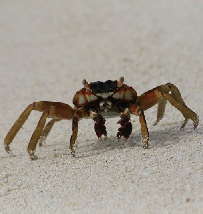
"Life is wonderful! Life is grand! There's no doubt about it: We seriously need life. ... Just one question. ... What is life?"
Biology is the study of living things, but is there a universally accepted definition of "living things"? Not exactly, although just about everyone agrees that biology is not the study of rocks.
It is difficult to strictly define something as mysterious and fundamental as "life." However, we can describe "life" by listing the characteristics common to all known life-forms. So that's what we'll do.
You can think of the rest of this page as an "Am I an Earthling?" checklist. If you have all the following characteristics, there's a good chance that you're a living creature from planet Earth.
All living things on our planet share specific Ingredients, as well as specific Behaviors. We'll describe the ingredients of earthlings first and their behaviors second.
Living things on this planet are made primarily of water molecules and complex organic molecules. (In this case, "organic" is a chemical term that means "carbon-based.")
As you may have heard—the rumor's been out for hundreds of years now—, these molecules are organized into units called "cells." Cells are the smallest units of life: cells are made of nonliving things but are themselves alive, and all living things are made of cells.

All living creatures share some basic behaviors. Some of these behaviors occur only in the cells of organisms; some occur throughout entire organisms (of course one-celled organisms perform organism-wide behaviors in the space of one cell); and some occur not within individual living things but within groups of living things.
In our first section on behaviors, we describe (I) the behaviors shared by all living cells. In the next section, we list (II) the behaviors that all cells and all living creatures share. In the final section, we describe (III) the behaviors of living species.
The behaviors of all life on earth start with the behaviors of cells.
All living cells (1) store and exactly follow precise instructions (genetic information contained in their DNA) to (2) build the complex organic molecules (usually proteins) that run the cell.
Examples of the complex molecules in charge of a cell's routine operations include enzymes, which control chemical reactions inside cells, and antibodies, which protect cells from for foreign invaders.
The constant busyness of such molecules brings life to cells and (ultimately) to organisms made of cells.
And that brings us to our next set of behaviors: behaviors found in both individual cells and organisms made up of cells.
Cells and those of us built out of cells all do these four things:
(1) Monitor their surroundings. (One‐celled bacteria can sense food and so can we.)
Monitoring their environment allows cells and larger organisms to (2) purposefully collect matter and energy while avoiding threats. (Both bacteria and animals move towards things they can eat and away from dangerous situations. Cells inside of larger bodies have some control over what they allow in and out of their cell membranes or cell walls. Even those "do‐nothing" plants grow towards the light.)
But of course, that's not all. Matter and energy are no good to a cell or multicellular organism unless these living things (3) convert the gathered matter and energy into fuels and building materials, and then (4) use these fuels and/or building materials to monitor, develop, and maintain themselves. (Cells are constantly reviewing and rebuilding themselves, and our bodies are too.)
As you can see, the primary attribute of living things that distinguishes them from nonliving things is that living things take charge of their own destiny.
But that's not the whole story. Sometimes—given the right lighting—a living cell or organism shows even more initiative and (5) reproduces! Which brings us to our final category of behaviors: the behaviors of living species.
When a living cell or organism reproduces, a new living thing is created with a lot but not all of the same genetic information of its parent or parents. [For an explanation of how this works see 1.]
Because children are similar to but not always exactly the same as their parent or parents, species of living things have genetic variety. Because of genetic variety, groups of living things can adapt to new and/or changing environments over time.

In short, we living creatures are energy and matter using energy and matter to follow precise instructions that cause us to use energy and matter to gather more energy and matter, using this energy and matter to develop and maintain ourselves in a manner that will allow us to keep gathering and using energy and matter.
Oh,—and then, sometimes we divide in two or get married or whatever is customary and create new beings a little different from ourselves, some of whom will be even better suited to our environment than we are.
Round and round it goes! How can such things be?
That question is outside the scope of this website. However, we could talk a little more about the details. Like, for example,
How exactly does a cell use the energy sources its gathered from its surroundings to power all its activities?
FT Exploring already has some pages touching upon this topic (like photosynthesis basics).
I've also written a couple of pages focusing just on the basics of cellular metabolism.
Page Last Updated: 10/16/2020
1 How reproduction guarantees that the offspring has a lot but not always all of the same genetic material as its parent.
(1) In the case of asexual reproduction (an organism reproduces by itself).
When an organism reproduces all by its lonesome, it divides in half and so it often creates
an organism with the exact same genetic information as itself. However, sometimes a tiny mistake or two occurs while
the genetic information from the original organism is copied to create a new organism.
When this happens, the new organism will have a slightly different genetic make–up than its parent.
(2) In the case of sexual reproduction.
When two organisms reproduce together, their genetic material is jumbled together in their child's DNA, so a
child is never exactly like either of parent.
Hey!
We never interupt content with ads!
How rare and cool is that?!
Help us keep it that way by using the share button below: